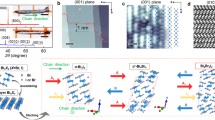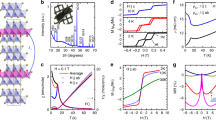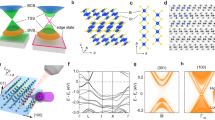Abstract
Low-dimensional van der Waals materials have been extensively studied as a platform with which to generate quantum effects. Advancing this research, topological quantum materials with van der Waals structures are currently receiving a great deal of attention. Here, we use the concept of designing topological materials by the van der Waals stacking of quantum spin Hall insulators. Most interestingly, we find that a slight shift of inversion centre in the unit cell caused by a modification of stacking induces a transition from a trivial insulator to a higher-order topological insulator. Based on this, we present angle-resolved photoemission spectroscopy results showing that the real three-dimensional material Bi4Br4 is a higher-order topological insulator. Our demonstration that various topological states can be selected by stacking chains differently, combined with the advantages of van der Waals materials, offers a playground for engineering topologically non-trivial edge states towards future spintronics applications.
This is a preview of subscription content, access via your institution
Access options
Access Nature and 54 other Nature Portfolio journals
Get Nature+, our best-value online-access subscription
$29.99 / 30 days
cancel any time
Subscribe to this journal
Receive 12 print issues and online access
$259.00 per year
only $21.58 per issue
Buy this article
- Purchase on Springer Link
- Instant access to full article PDF
Prices may be subject to local taxes which are calculated during checkout




Similar content being viewed by others
Data availability
The data that support the findings of this study are available from the corresponding authors upon request.
References
Fu, L., Kane, C. L. & Mele, E. J. Topological insulators in three dimensions. Phys. Rev. Lett. 98, 106803 (2007).
Hasan, M. Z. & Kane, C. L. Colloquium: topological insulators. Rev. Mod. Phys. 82, 3045–3067 (2010).
Rasche, B. et al. Stacked topological insulator built from bismuth-based graphene sheet analogues. Nat. Mater. 12, 422–425 (2013).
Liu, C.-C., Zhou, J.-J., Yao, Y. & Zhang, F. Weak topological insulators and composite Weyl semimetals: β-Bi4X4 (X = Br, I). Phys. Rev. Lett. 116, 066801 (2016).
Noguchi, R. et al. A weak topological insulator state in quasi-one-dimensional bismuth iodide. Nature 566, 518–522 (2019).
Zhang, F., Kane, C. L. & Mele, E. J. Surface state magnetization and chiral edge states on topological insulators. Phys. Rev. Lett. 110, 046404 (2013).
Khalaf, E. Higher-order topological insulators and superconductors protected by inversion symmetry. Phys. Rev. B 97, 205136 (2018).
Matsugatani, A. & Watanabe, H. Connecting higher-order topological insulators to lower-dimensional topological insulators. Phys. Rev. B 98, 205129 (2018).
Po, H. C., Vishwanath, A. & Watanabe, H. Symmetry-based indicators of band topology in the 230 space groups. Nat. Commun. 8, 50 (2017).
Song, Z., Zhang, T., Fang, Z. & Fang, C. Quantitative mappings between symmetry and topology in solids. Nat. Commun. 9, 3530 (2018).
Zhang, T. et al. Catalogue of topological electronic materials. Nature 566, 475–479 (2019).
Vergniory, M. G. et al. A complete catalogue of high-quality topological materials. Nature 566, 480–485 (2019).
Tang, F., Po, H. C., Vishwanath, A. & Wan, X. Comprehensive search for topological materials using symmetry indicators. Nature 566, 486–489 (2019).
Khalaf, E., Po, H. C., Vishwanath, A. & Watanabe, H. Symmetry indicators and anomalous surface states of topological crystalline insulators. Phys. Rev. X 8, 031070 (2018).
Schindler, F. et al. Higher-order topology in bismuth. Nat. Phys. 14, 918–924 (2018).
Serra-Garcia, M. et al. Observation of a phononic quadrupole topological insulator. Nature 555, 342–345 (2018).
Imhof, S. et al. Topolectrical-circuit realization of topological corner modes. Nat. Phys. 14, 925–929 (2018).
Peterson, C. W., Benalcazar, W. A., Hughes, T. L. & Bahl, G. A quantized microwave quadrupole insulator with topologically protected corner states. Nature 555, 346–350 (2018).
Xue, H., Yang, Y., Gao, F., Chong, Y. & Zhang, B. Acoustic higher-order topological insulator on a kagome lattice. Nat. Mater. 18, 108–112 (2019).
Ni, X., Weiner, M., Alù, A. & Khanikaev, A. B. Observation of higher-order topological acoustic states protected by generalized chiral symmetry. Nat. Mater. 18, 113–120 (2019).
Kempkes, S. N. et al. Robust zero-energy modes in an electronic higher-order topological insulator. Nat. Mater. 18, 1292–1297 (2019).
von Benda, H., Simon, A. & Bauhofer, W. Zur Kenntnis von BiBr und BiBr1,167. Z. Anorg. Allg. Chem. 438, 53–67 (1978).
Filatova, T. et al. Electronic structure, galvanomagnetic and magnetic properties of the bismuth subhalides Bi4I4 and Bi4Br4. J. Solid State Chem. 180, 1103–1109 (2007).
Zhou, J.-J., Feng, W., Liu, C.-C., Guan, S. & Yao, Y. Large-gap auantum spin Hall insulator in single layer bismuth monobromide Bi4Br4. Nano Lett. 14, 4767–4771 (2014).
Zhou, J.-J., Feng, W., Liu, G.-B. & Yao, Y. Topological edge states in single- and multi-layer Bi4Br4. New J. Phys. 17, 015004 (2015).
Tang, F., Po, H. C., Vishwanath, A. & Wan, X. Efficient topological materials discovery using symmetry indicators. Nat. Phys. 15, 470–476 (2019).
Hsu, C.-H. et al. Purely rotational symmetry-protected topological crystalline insulator α-Bi4Br4. 2D Mater. 6, 031004 (2019).
Li, X. et al. Pressure-induced phase transitions and superconductivity in a quasi-one-dimensional topological crystalline insulator α-Bi4Br4. Proc. Natl Acad. Sci. USA 116, 17696–17700 (2019).
Fang, C. & Fu, L. New classes of topological crystalline insulators having surface rotation anomaly. Sci. Adv. 5, eaat2374 (2019).
Zhang, T. et al. Topological crystalline insulators with C2 rotation anomaly. Phys. Rev. Res. 1, 012001 (2019).
Lai, K., Kundhikanjana, W., Kelly, M. & Shen, Z. X. Modeling and characterization of a cantilever-based near-field scanning microwave impedance microscope. Rev. Sci. Instrum. 79, 063703 (2008).
Lv, B., Qian, T. & Ding, H. Angle-resolved photoemission spectroscopy and its application to topological materials. Nat. Rev. Phys. 1, 609–626 (2019).
Shimojima, T., Okazaki, K. & Shin, S. Low-temperature and high-energy-resolution laser photoemission spectroscopy. J. Phys. Soc. Jpn 84, 72001 (2015).
Zhang, P. et al. A precise method for visualizing dispersive features in image plots. Rev. Sci. Instrum. 82, 043712 (2011).
Cao, Y. et al. Correlated insulator behaviour at half-filling in magic-angle graphene superlattices. Nature 556, 80–84 (2018).
Cao, Y. et al. Unconventional superconductivity in magic-angle graphene superlattices. Nature 556, 43–50 (2018).
Tran, K. et al. Evidence for moiré excitons in van der Waals heterostructures. Nature 567, 71–75 (2019).
Alexeev, E. M. et al. Resonantly hybridized excitons in moiré superlattices in van der Waals heterostructures. Nature 567, 81–86 (2019).
Seyler, K. L. et al. Signatures of moiré-trapped valley excitons in MoSe2/WSe2 heterobilayers. Nature 567, 66–70 (2019).
Jin, C. et al. Observation of moiré excitons in WSe2/WS2 heterostructure superlattices. Nature 567, 76–80 (2019).
Hsu, C.-H., Stano, P., Klinovaja, J. & Loss, D. Majorana Kramers pairs in higher-order topological insulators. Phys. Rev. Lett. 121, 196801 (2018).
Jäck, B. et al. Observation of a Majorana zero mode in a topologically protected edge channel. Science 364, 1255–1259 (2019).
Perdew, J. P., Burke, K. & Ernzerhof, M. Generalized gradient approximation made simple. Phys. Rev. Lett. 77, 3865–3868 (1996).
Kresse, G. & Joubert, D. From ultrasoft pseudopotentials to the projector augmented-wave method. Phys. Rev. B 59, 1758–1775 (1999).
Kresse, G. & Hafner, J. Ab initio molecular dynamics for liquid metals. Phys. Rev. B 47, 558–561 (1993).
Kresse, G. & Hafner, J. Ab initio molecular-dynamics simulation of the liquid-metal-amorphous-semiconductor transition in germanium. Phys. Rev. B 49, 14251–14269 (1994).
Kresse, G. & Furthmüller, J. Efficiency of ab initio total energy calculations for metals and semiconductors using a plane-wave basis set. Comput. Mater. Sci. 6, 15–50 (1996).
Kresse, G. & Furthmüller, J. Efficient iterative schemes for ab initio total-energy calculations using a plane-wave basis set. Phys. Rev. B 54, 11169–11186 (1996).
Becke, A. D. & Johnson, E. R. A simple effective potential for exchange. J. Chem. Phys. 124, 221101 (2006).
Blaha, P. et al. WIEN2k: An Augmented Plane Wave Plus Local Orbitals Program for Calculating Crystal Properties (Techn. Universitat, 2018).
Marzari, N. & Vanderbilt, D. Maximally localized generalized Wannier functions for composite energy bands. Phys. Rev. B 56, 12847–12865 (1997).
Souza, I., Marzari, N. & Vanderbilt, D. Maximally localized Wannier functions for entangled energy bands. Phys. Rev. B 65, 035109 (2001).
Kuneš, J. et al. Wien2wannier: from linearized augmented plane waves to maximally localized Wannier functions. Comput. Phys. Commun. 181, 1888–1895 (2010).
Pizzi, G. et al. Wannier90 as a community code: new features and applications. J. Phys. Condens. Matter 32, 165902 (2020).
Yaji, K. et al. High-resolution three-dimensional spin- and angle-resolved photoelectron spectrometer using vacuum ultraviolet laser light. Rev. Sci. Instrum. 87, 53111 (2016).
Dudin, P. et al. Angle-resolved photoemission spectroscopy and imaging with a submicrometre probe at the SPECTROMICROSCOPY-3.2L beamline of Elettra. J. Synchrotron Radiat. 17, 445–450 (2010).
Ishida, Y. & Shin, S. Functions to map photoelectron distributions in a variety of setups in angle-resolved photoemission spectroscopy. Rev. Sci. Instrum. 89, 043903 (2018).
Acknowledgements
We thank D. Hamane for SEM characterization of the sample surface. We also thank X. Ma and D. Abeysinghe for their support in the exfoliation of Bi4Br4 samples. The work done at Tokyo Institute of Technology was supported by a CREST project [JPMJCR16F2] from Japan Science and Technology Agency (JST). The GISAXS experiments were performed under the approval of PF-PAC number 2018G661. We thank Diamond Light Source for access to beamline I05 under proposal SI20445, which contributed to the results presented here. Use of the Stanford Synchrotron Radiation Lightsource at the SLAC National Accelerator Laboratory is supported by the U.S. Department of Energy, Office of Science, Office of Basic Energy Sciences under contract no. DE-AC02-76SF00515. The MIM work was supported by the United States Army Research Office under grant number W911NF-17-1-0542. This work was supported by the JSPS KAKENHI (grant numbers JP18H01165, JP18K03484, JP19H02683, JP19F19030 and JP19H00651), and by MEXT Q-LEAP (grant number JPMXS0118068681). R.N. acknowledges support by JSPS under KAKENHI grant number JP18J21892 and support by JSPS through the Program for Leading Graduate Schools (ALPS). This work was also supported by MEXT under the “Program for Promoting Researches on the Supercomputer Fugaku” (Basic Science for Emergence and Functionality in Quantum Matter Innovative Strongly Correlated Electron Science by Integration of “Fugaku” and Frontier Experiments) (Project ID: hp200132).
Author information
Authors and Affiliations
Contributions
T.K. and T. Sasagawa planned the experimental project. R.N. conducted ARPES experiments and analysed the data. K. Kuroda, P.Z., C.L., C.B., S. Sakuragi, H.T., S.K., K. Kurokawa, K.Y., A.H., V.K., A.G., A.B., T.K.K., C.C., M. Hashimoto, D. Lu, S. Shin and T.K. supported the ARPES experiment. R.N., Z.J., Z.X., D. Lee and K.L. performed MIM experiments and analysed the data. M.K., T.T. and T. Sasagawa made and characterized Bi4Br4 single crystals and performed transport experiments. R.N. and M.K. collected laser microscope images. T. Shirasawa performed the GISAXS experiments. R.N. performed the SEM experiment. T. Sasagawa, M. Hirayama, M.O. and R.A. calculated the band structure and analysed the band topology. R.N., Z.J., K. Kuroda, M. Hirayama, M.O., T. Shirasawa, K.L., T. Sasagawa and T.K. wrote the paper. All authors discussed the results and commented on the manuscript.
Corresponding authors
Ethics declarations
Competing interests
The authors declare no competing interests.
Additional information
Peer review information Nature Materials thanks Xingjiang Zhou and the other, anonymous, reviewer(s) for their contribution to the peer review of this work.
Publisher’s note Springer Nature remains neutral with regard to jurisdictional claims in published maps and institutional affiliations.
Supplementary information
Supplementary Information
Supplementary Notes 1–14, Figs. 1–4 and references.
Rights and permissions
About this article
Cite this article
Noguchi, R., Kobayashi, M., Jiang, Z. et al. Evidence for a higher-order topological insulator in a three-dimensional material built from van der Waals stacking of bismuth-halide chains. Nat. Mater. 20, 473–479 (2021). https://doi.org/10.1038/s41563-020-00871-7
Received:
Accepted:
Published:
Issue Date:
DOI: https://doi.org/10.1038/s41563-020-00871-7
This article is cited by
-
Second order topology in a band engineered Chern insulator
Scientific Reports (2024)
-
Quantum transport response of topological hinge modes
Nature Physics (2024)
-
Spin-resolved topology and partial axion angles in three-dimensional insulators
Nature Communications (2024)
-
Spinful hinge states in the higher-order topological insulators WTe2
Nature Communications (2023)
-
Towards layer-selective quantum spin hall channels in weak topological insulator Bi4Br2I2
Nature Communications (2023)



